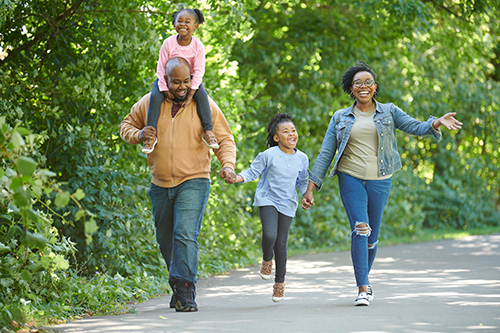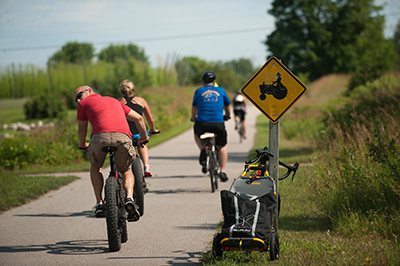By Mary McGuire

People use the term walkable or walkability when describing neighborhoods, downtowns, college campuses, shopping malls, tourist towns, and more. Though, what does it mean when we say something is walkable? According to the Merriam Webster Dictionary, since 1736, the term walkable has been defined as “capable of or suitable for being walked – a very walkable city – a walkable distance.” When the term walkable is used today, it implies the distance between point A and point B is something that is either convenient, environmentally friendly, easily accessible, an efficient use of time (and money), and safe for all involved.
Though, when people think about the walkability of a place, does it also influence whether people will consider be physically active by walking, rolling, biking, etc. in that space? Michigan Fitness Foundation (MFF) thinks it does. MFF plays a vital role in promoting the health of Michigan’s citizens by working in conjunction with the executive office and state agencies, nonprofits, and corporate partners to help Michiganders live healthier lives. And to do this, MFF looks to find solutions that inspire people to be more physically active in their daily lives.
“One way we do this is by offering a variety of grant funded programs for schools, communities, and nonprofit organizations that inspire healthy living,” says MFF President & CEO Amy Ghannam. “For example, our Promoting Active Communities (PAC) resource is a set of online tools with a multi-tiered approach that helps communities find solutions to create and maintain active communities, while our Safe Routes to School program provides grants to help understand obstacles and support infrastructure improvements along with safety education to encourage walking and bicycling to school.”
Understanding what makes an environment walkable is the first step to addressing walkability.
The PAC works by evaluating the built environment, policies, and programs related to promoting and supporting physical activity in a community, which helps communities better understand obstacles to active living and solutions to overcome those obstacles. It requires a team of interested community members to use the online tools, virtually and on the ground, to examine their community’s policies, programs, and built environment.
“The PAC asks those involved to go out and walk and bike places in their community to gain firsthand knowledge about the design and maintenance of the built environment,” says MFF Senior Director of Community Impact Sarah Panken “In this way, they experience current conditions and can identify the assets and obstacles to best understand what someone would experience when using human-powered or what we call active transportation modes like walking, cycling, rolling, skateboarding, etc., to reach destinations in their community.”
After completing the evaluation of the built environment, policies, and programs related to promoting and supporting physical activity, communities are provided with score and a feedback report personalized for their community. Using their community feedback report, the team is better equipped to address issues and work to create more vibrant places for residents to be physically active.
Obstacles to physical activity impact the ability for people to move freely and safely and this minimizes the opportunities for a person to consider walking in their community or use other active transportation methods. Some of the challenges to active transportation that are revealed while using the PAC include a lack of sidewalks and curb cuts, or low curbs to ease transitions when crossing streets, poor street conditions, no places for people to rest along the way, exposure to pollution, and other things like how speeding and traffic congestion complicates crossing streets with ease. Obstacles are also born from the unintended consequence from policies set in place at the municipal level.
“When assessing and experiencing the street environment and safety measures alongside a community’s planning documents, municipal codes, and development review processes, it becomes more evident which policies and systems help or hinder the ability for people to be active in their community,” says Panken. “For example, updating ordinances that would require developers to ensure there are sidewalks in any new development, and to consider how the land use surrounding those developments supports mobility regarding pedestrians and cyclists would be useful.”
Then the PAC also asks the team to review current programs, education, and outreach and think about how their community can enhance and build awareness for physical activity opportunities.
For the last two decades, Michigan communities have been recognized for making changes that encourage residents to be physically active through their use of the PAC. By making pedestrian and bicycle improvements, updates to city zoning, and offering more recreation opportunities, they have made it easier for residents to be physically active in their daily lives.
An example of a community that has done this work is Traverse City in Northwest Michigan. Back in the 90s, the City looked at their downtown and set a goal for mixed-use development and to create walkable and bikeable community. By the 2000s, they were well on their way and received a Promoting Active Communities Award in 2001 for their efforts. Though, they didn’t stop there.

Today, with support from residents and groups like Norte, TART Trails, and a robust Safe Routes to School program, over 20 miles of sidewalk have been built or reconstructed and millions of dollars have been invested in walkable infrastructure. Traverse City began prioritizing improvements in areas with low walkability scores, then organized funding from a 15-year bond, allocating more funds in the City budget to sidewalks, and through Safe Routes to School program grants.
Safe Routes to School (SRTS) is a grant program that focuses on encouraging students in grades K-12 to walk, roll, and bike to school. The program fits together well with the PAC and can be implemented at the state, community, or local school district level. Generally, education, transportation, public safety, and city planning agencies coordinate efforts to implement a Safe Routes to School program.
Norte administers Safe Routes To School programs across the Grand Traverse Region and teaches students to develop lifelong habits to move more, sit less, and be physically active as part of ordinary life. And according to Norte, the region has seen a 463% growth in student participation in Norte’s walk and bike school programs since 2013. Currently, there is $2.1 million Safe Routes to School Infrastructure Grant being implemented in Traverse City.
“Safe Routes to School is designed to create healthier communities. Our grantees, like Norte, work with a consortium of agencies on a variety of issues such as pedestrian and bicycle safety, reducing traffic congestion around schools that improves air quality, and by addressing obstacles around the infrastructure to make it safer and easier to get to and from school,” says MFF Director of Safe Routes School Mary Moomaw. “Safe Routes is a catalyst for change in the physical environment as well as in the minds of parents and caregivers as so many believe it is too dangerous for children to walk, roll or bike to school because of speeding, unsafe intersections, and more. The work Norte has done and continues to do is a model for other communities looking to launch a Safe Routes to School program.”
Norte is shifting perspectives as they address issues by educating children and their parents through their school-based events, education, and encouragement programs. As a result, families are more willing to let their children walk and roll to school, which gives them greater autonomy while improving their health and well-being.
By offering grants and programs like the PAC and Safe Routes to Schools programs to schools and nonprofit organizations like Norte, Michigan Fitness Foundation is helping to create walkable environments where people can be more physically active in their daily lives.

